 |
This is a file from the Wikimedia Commons. Information from its description page there is shown below.
Commons is a freely licensed media file repository. You can help.
|
Summary
| Description |
English: The Historical Transit of Mercury on November 8,2006. Please note that sunspot #923, which is just below the equator at the left-hand side, is much bigger than Mercury is. You can also see two more sunspots at the right-hand side at the equator. You can see Mercury as a small black dot in the lower middle of the solar disk. The picture was taken with a white filter.
Русский: Историческое прохождение Меркурия по диску Солнца 8 ноября 2006 года. Обратите внимание на солнечное пятно чуть ниже экватора в левой части, которое намного больше Меркурия. Заметны также еще два солнечных пятна на экваторе в правой части. Меркурий виден как маленькая черная точка в середине нижней части солнечного диска. Снимок сделан с белым фильтром.
|
| Date |
11/08/06 |
| Source |
Own work |
| Author |
Brocken Inaglory |
Licensing
I, Brocken Inaglory, the copyright holder of this work, hereby publishes it under the following licenses:
 |
Permission is granted to copy, distribute and/or modify this document under the terms of the GNU Free Documentation License, Version 1.2 or any later version published by the Free Software Foundation; with no Invariant Sections, no Front-Cover Texts, and no Back-Cover Texts. A copy of the license is included in the section entitled GNU Free Documentation License. http://www.gnu.org/copyleft/fdl.htmlGFDLGNU Free Documentation Licensetruetrue
|
You may select the license of your choice.
|
| Annotations |
This image is annotated: View the annotations at Commons |
|
|
1117
1333
27
27
2000
2000
1790
1000
27
37
2000
2000
File usage
The following pages on Schools Wikipedia link to this image (list may be incomplete):
SOS Childrens Villages has brought Wikipedia to the classroom. SOS Childrens Villages believes education is an important part of a child's life. That's why we ensure they receive nursery care as well as high-quality primary and secondary education. When they leave school, we support the children in our care as they progress to vocational training or higher education. If you'd like to help, why not learn how to sponsor a child?



